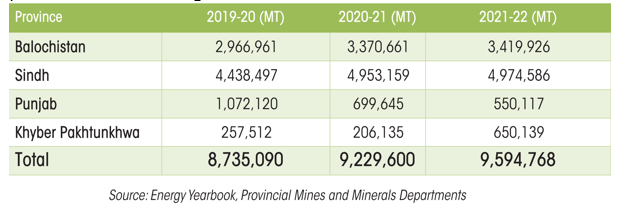i INP-WEALTHPK
Uzair bin Farid
Sindh produced more coal than any other province in 2021-22, with 4.974 million tonnes (MT). According to the data available with WealthPK, Balochistan province followed with an annual production of 3.419MT in the same year. Khyber Pakhtunkhwa province trails Balochistan with the production of coal amounting to 0.65MT in FY22. Punjab comes in the last place with the total annual coal production standing at 0.55MT in FY22.

The total coal production in the country stood at 9.5MT in FY22, which is a 4% increase over the production levels of the previous year (2021), when the total coal produced was 9.2MT. Overall, coal production is increasing, which shows that the dependence of Pakistan on imported coal is decreasing with every passing year, which will enable the country to fuel its coal-fired power plants from indigenous coal in the future. Pakistan has large coal reserves with more than 186 billion tonnes still to be mined. These coal reserves are enough to help Pakistan meet its energy requirements in the long-run on a sustainable basis. Pakistan’s indigenous production of coal was given a boost with the commercial launch of the Thar Coalfield Block-I, which has the capacity to produce 7.8 million tonnes of coal per annum.
Similarly, after the start of mining from Block-II, 7.6 million tonnes more were added to the domestic coal production. Almost all the coal that is produced from the coal mines of Thar is utilised in the power plants situated there. Coal mined from other regions of the country is used as fuel in brick kilns, which are an essential support base to sustain the real estate sector of the country. Since climate change has started to pose a serious threat to the survival of humans, the government of Pakistan is working strenuously to ensure alternate utilisation of coal by converting it into gas and liquids so that the harmful effects in producing electricity from coal can be limited. To that end a Coal Gasification Policy is also being prepared by the Ministry of Energy’s Petroleum Division.
As soon as the ‘zero-draft’ of the policy is ready it will be shared with relevant stakeholders to get their input before submitting it to the competent authority for final approval. The government is also working to increase the share of indigenous coal in power plants situated in Sahiwal, Hub, Port-Qasim and Jamshoro. To reduce energy consumption, the cement industry is increasing coal use in its production process. The utilisation of indigenous coal to produce power and fuel other industrial sectors is a hopeful prospect for the country. However, it must be remembered that the world is moving away from fossil fuels and other sources of energy production, including coal, as they pollute the environment and add to global warming. A joint effort by the government and the private sector is needed to establish renewable energy transitions.
Credit: INP-WealthPk



